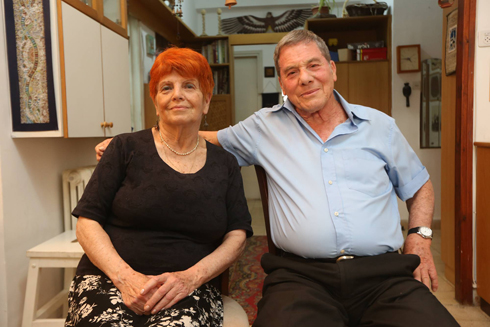
Couple adopt abandoned grave of fallen soldier
Zehava and Avner Hanoch embarked on a private mission to learn more on a fallen soldier of whom little was known. Four years later, the story of Emanuel Fogel, a Holocaust survivor who fought and died in 1948, is finally known.
A shy smile in a blurry picture is all that Emanuel (Munio) Fogel left behind. Fogel was 18 years old when he was killed, but for years he was considered an "unknown soldier"; it took years for Israel's security establishment to identify him, but even then, his life story was still incomplete.
In 2011, Zehava and Avner Hanoch, an elderly couple from Jerusalem, were on a visit to the Mount Herzl national cemetery when heard about graves of fallen soldiers that receive no visitors.
"The people from the project 'Every Fallen Soldier Has a Story' were looking for volunteers to adopt tombstones of forgotten soldiers," said Zehava. "We were given a list of names, we chose Emanuel, and Avner said Kaddish."
The couple joined the project, led by the Department of Families and Commemoration at the Defense Ministry. As part of the project, the unit offers details on the lives of soldiers who fell decades ago. The couple investigated, turned to archives, and eventually located Fogel's friends and even met with them.
Related stories:
- Memorial Day: Israel prepares to honor 23,169 fallen soldiers
- 'Netanel insisted on serving as a fighter'
"The only information his tombstone contained was his name, last name and the place and date of fall," said Avner. "We received a list of people who served with him during his basic training, and slowly the picture became clearer."
Delving deeper into the details of Emanuel Fogel's life revealed that he was born in Romania in 1930 and as a child was sent with his family to a concentration camp, where his family perished. He survived, and after World War II ended, he was sent to an orphanage.
In 1945, he arrived in Israel on immigrants' ship. He was first sent to Petah Tikva to study, and afterwards he was recruited to the Palmach's Harel Brigade.
The couple turned to the Zionist archive and got a hold on a list of immigrants who arrived to Israel on the ship "Transylvania" in October 1945. The list included a student card with the name "Emanuel (Munio) Fogel" and another card with the name "Meir Fogel" written on it.
Once it became clear that Meir was Emanuel's brother, the couple cross-referenced the information with Yad Vashem's collection of Holocaust testimonies, and discovered the names of the brothers' parents.
"It was a known fact that Emanuel had a brother, but he died a few years after him, long before we entered the picture," said Avner. "We had some difficulties locating people who met the brother and heard his story, because he wasn't in touch with anyone."
In one of the documents the couple uncovered, they found the name of one of Munio's guardians. "We traced the name and discovered it belonged to a soap factory owner from Rishon LeZion. We managed to reach his daughter who is currently living at a nursing home, but she had a hard time telling us what was the family connection between them."
Fogel was considered an unknown soldier until 2001, but an investigation conducted by the IDF's EITAN Unit (a unit for the detection of missing soldiers) found that Fogel's body was not identified because it did not appear in the Palmach's list of missing soldiers.
When the investigation concluded, it was determined that the unknown soldier was undoubtedly Emanuel Fogel. In July 2001, more than 50 years after his death, a military service was conducted during which a tombstone with his name on it was laid in a joint grave with his brother.
No stone unturned
Edna Huna, a senior assistant in the Defense Ministry's commemoration unit, said that the couple requested that the names of Emnauel Fogel's parents be added to his tombstone.
"There were 700 soldiers killed between the years 1940-50, with much of the information about them missing. We are not giving up on anyone, because each and every one meant something to someone."
Uri Sagi, the project's coordinator, said that the project was born because of the massive lack of information about soldiers who were killed in the Battle of Jenin in 1948.
"Every volunteer gets a name of a fallen soldier to research and investigate. They try to locate relatives and friends from that time, go to various archives and sift though the information. Our job is to assist and support when the volunteers reach a dead end," added Sagi.













